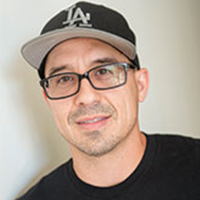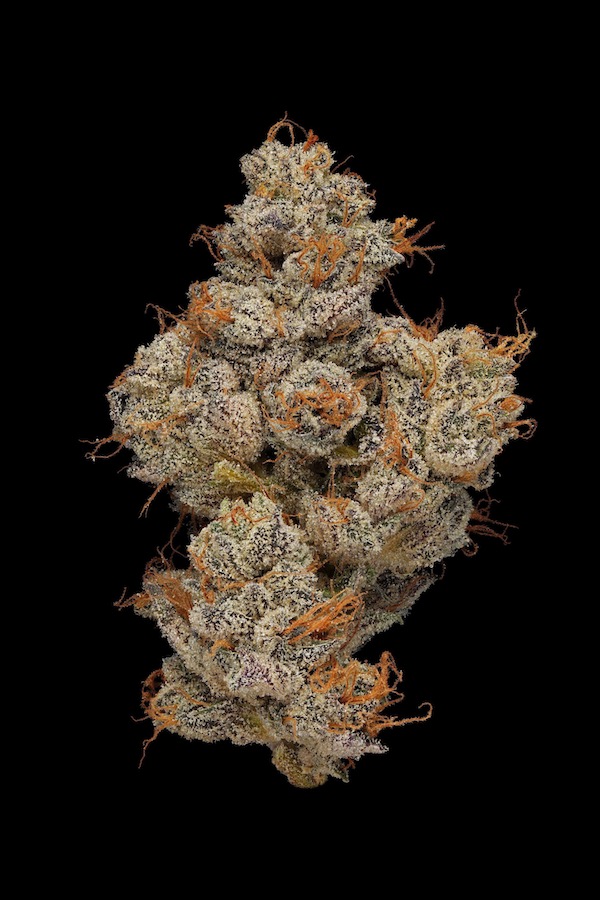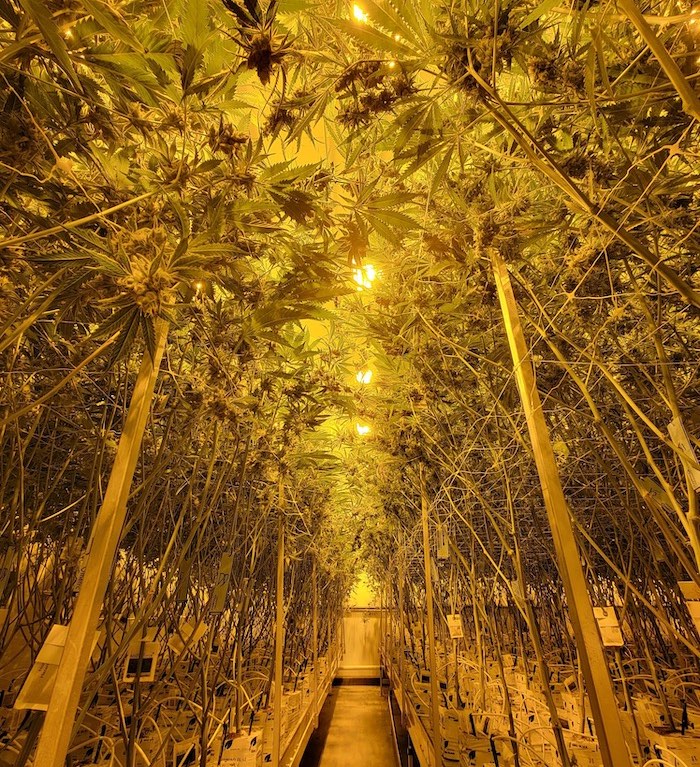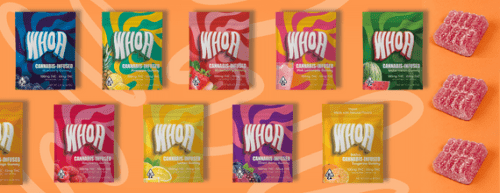“Because I’m stupid, I’m a glutton for punishment,” David Holmes CEO and Founder of Clade 9 says after I asked him what keeps his passion for cultivation stoked like a surfer in the depths of a twelve-foot swell.
“Phenotype hunting and breeding and seeing new varieties, that shit is really cool. As hard as it is and as much money as I’m losing, I’m like man this is still really fun,” Holmes told me over the phone with a smile drawn so wide that I could hear it through the phone. Holmes’s passion for the weed game has been the catalyst for Clade 9’s ascension to one of the top-quality brands in California’s legal cannabis system.

Hard Way Hustle
Clade 9 has found its home nestled at the crossroads of an illegal industry trying to turn legit. Clade 9 proudly stands by its slogan “Grown the hard way.” The name was created as an ode to the Delta 8 cannabinoid and to escape the cringe “canna” naming craze. Holmes and his partners learned how to grow weed the traditional way – in the shadows of the black market perfecting their craft all while hiding from the federal government and other types of nefarious mother fuckers that want to steal your market space.
Holmes had his first experience with cannabis sales when he was nine years old. He helped his brother trim buds off of plants growing in his uncle’s backyard. They processed the weed back at his brother’s house, it was hung and dried in an old record player lid. Then it was packaged and Holmes was off to sell it to his classmates at school. He and his brother were quickly busted and that exciting day turned into a tough learning experience after his older brother was arrested by the LAPD. Luckily both kids were no older than middle schoolers, so they were given slaps on the wrist and nothing too serious came out of it.
From there Holmes took a long break from his relationship with cannabis until he was reintroduced to cannabis while attending college in 1999. A study session quickly turned into a smoke session after David smelt the fire one of his classmates had on him. This dude told Holmes that it was homegrown Hawaiian and he grew it himself at his hydroponic laboratory somewhere near San Francisco.
Eventually, Holmes visited his friend’s grow and saw more of the dank Hawaiian he smelled before. After he saw the White Widow that was also being grown it was all he needed to see – the cultivation bug bit him and he set out to start growing weed himself.
Solving the Rubiks Cube
Holmes was mostly curious about the scientific process of cannabis cultivation. At the time he was pursuing his mathematics degree and focused on his love of math and science and quickly noticed many similarities in the cultivation game. His first grow was a 1000 HPS light and a wall air conditioning unit set up in his girlfriend’s garage, Holmes told Mitch Pfeifer on the RMR Podcast.
Dave likens himself to the hardcore mathematicians that live in their mom’s basement filling entire chalkboards with calculations and working on a single problem for weeks on end. “Unfortunately, I have some of that in me,” Holmes said.
Even after his operation was raided in 2013 it never scared him out of the garden but it did motivate him to go legit. Despite the mountain of issues legal cannabis producers have to climb in California, he presses on without any regrets.
Taxes, overproduction, the black market’s continued success, as well as over-regulation are just a few of the major issues California cultivators face while trying to produce within the confines of the legal market. If anything, California’s messy legal system just gives Clade 9 a few more puzzle pieces to find and fit into place.
Modern-day cannabis connoisseurs provide their own Rubiks cube of needs. They’re more knowledgeable than ever before making them pickier than ever before. Think of wine lovers perusing the liquor store isles for the perfect vintage to pair with their veal parmigiana.
While it’s great for consumers to have more information to increase their buying power, it creates an interesting set of parameters that cultivators have to adhere to make their money. These parameters basically create misleading and reductive parameters that limit the type of cannabis strains legal growers can create. Some of these parameters include THC percentages, how buds look through a glass jar, and the dreaded sativa, indica, or hybrid classifications.

Strain Family Trees
Clade 9 doesn’t use sativa, indica, and hybrid terms when discussing their cannabis strains. Rather they speak avidly about strain families their plants reside in and the terpene profiles their phenotypes express.
They have their respective families printed boldly on the jar with the goal of helping teach retail consumers and budtenders more about what makes their plants smell and taste the way they do. Strains in the same family are of course different but share many essential qualities and might produce similar terpene profiles.
For example, Super Lemon Haze and Tangie are both classified as sativa strains. Many budtenders would sell them under the guise that they have similar effects because they’re both sativas, but this couldn’t be farther from the truth. Super Lemon Haze is much more racy than Tangie is (at least in my experience) and their flavor profiles couldn’t be more different, sour lemon pepper versus a light tangy floral orange.
If we looked at this example through the Clade 9 lens – if you’re looking for a strain like Super Lemon Haze a budtender should recommend something else in the Haze family like a Dutch Treat strain. If someone asks for a strain reminiscent of Tangie – Tropicana Cookies would be an exotic hybrid that might fit the bill because breeders crossed Tangie with Girl Scout Cookies. Strain families and terpene profiles aren’t an exact science but they’re absolutely a step in the right direction.
Using strain families is a more accurate way to distinguish between the hundreds of colorful strain names you’ll see at your local dispensary. Take Clade 9’s best-selling Fig Bar strain for example. The name alone would have you thinking it has a sweet fruity nose to it but when you dig into the genetics you realize this probably won’t be the case. The Fig Bar strain is a Ghost OG, Girl Scout Cookie, and Emerald OG cross.

Growing Fig Bars
Holmes didn’t spend decades hustling illicitly and dodging the feds so that he could grow mediocre cannabis legally. He spends the same amount of time researching and experimenting with different phenotypes to give the market new flavors. The Fig Bar strain is a testament to all of the game Holmes soaked up over the years. Not only is the Fig Bar strain something new – it pays homage to his favorite strains, the ones he grew up smoking like OG Kush, Mendo Purps, and Pre ’98 Bubba.
Fig Bar hits all the retail qualifiers – its purple and green resinous nugs sell themselves through any glass jar. It has the THC percentages to wow the custies while still providing incredible effects that all the old OG heads will love.
For Holmes, growing weed at this level wasn’t possible without hustling new phenotypes in his garage and perfecting his craft at a time when cannabis cultivation was seen as nothing more than a criminal enterprise. He turned his hustle into an art form and his passion into a business. But for Holmes, it’s just another phenotype to find, another flavor to chase, and another problem to solve.
More Content
THE RELATIONSHIP BETWEEN BACKWOODS AND HIP-HOP
TERPENES FOR ANXIETY: 3 TERPS IN CANNABIS WITH STRESS-RELIEVING PROPERTIES
RAPPER WEED: WHICH RAPPERS HAVE CANNABIS PRODUCTS IN THE MARKET? WHO ACTUALLY HAS THE FIRE?
18 COMPANIES THAT DON’T DRUG TEST THEIR EMPLOYEES FOR WEED
7 TIPS FOR MARKETING CANNABIS AND CBD ON TIKTOK AND INSTAGRAM








